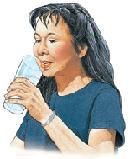Type 2 Diabetes
Treating High and Low Blood Sugar
Most of the time, you can keep your blood sugar in your target ranges. But sometimes your blood sugar will be too high or too low. You can't always feel when your blood sugar is high or low, so check it regularly, as directed by your healthcare team.
When Blood Sugar Is Too High
Too much glucose in your blood is called hyperglycemia or high blood sugar. It can be caused by eating too much food, especially carbohydrates, by not being active, or by not taking your medication. It can also be caused by sickness or stress.
Symptoms You May Have
High blood sugar may cause no symptoms. If you do have symptoms, they may include:
- Increased thirst
- A need to urinate more often
- Feeling tired
- Blurry vision
- Unexplained weight loss
- Itchy, dry skin
- Infections
- Wounds or skin infections that don't heal

When You Have Symptoms
Check your blood sugar. If it is higher than target range, take these steps:
- Drink sugar-free, caffeine-free liquids such as water, diet soda, or herbal tea.
- If your blood sugar is under 240, physical activity, such as a brisk walk, may help bring it down. If your blood sugar is over 240, do not exercise.
- If you take insulin, follow your healthcare provider's guidelines for taking extra insulin.
- Check your blood sugar every 2 to 4 hours, as directed by your healthcare team. If your blood sugar does not begin to come down within 24 hours, or if symptoms worsen, call your healthcare provider.
When Blood Sugar Is Too Low
Too little glucose in your blood is called hypoglycemia or low blood sugar. Diabetes itself doesn't cause low blood sugar. But some of the treatments for diabetes, such as pills or insulin, may put you at risk for it. Low blood sugar may occur if you take too much medication, skip or delay a meal, or are more active than usual. Always treat low blood sugar right away.
Symptoms You May Have
Get to know your own symptoms so you can tell when you have low blood sugar. Symptoms may include:
- Sweating or cold, clammy skin
- Shakiness or dizziness
- A hard, fast heartbeat
- Feelings of hunger
- Headache
- Confusion or irritability

When You Have Symptoms
Check your blood sugar to see if it's below target range. If you can't check it, treat the low anyway. To treat a low, take these steps:
- Eat or drink 15 grams of fast-acting sugar, such as 3 to 4 glucose tablets, 4 oz fruit juice or regular (non-diet) soda, 8 oz fat-free milk, or 1 tbsp of sugar. Don't take more than this, or your blood sugar may go too high.
- Wait 15 minutes. Then recheck your blood sugar if you can.
- If your blood sugar is still too low, repeat steps 1 and 2. If you aren't better after that, get medical help.
- Once your blood sugar returns to target range, eat. If your next meal is less than 1 hour away, eat that meal now. If it's more than 1 hour, eat a snack, such as half a sandwich, or crackers and cheese.
Call your healthcare provider if you have low blood sugar often. You may need a change in your treatment plan.